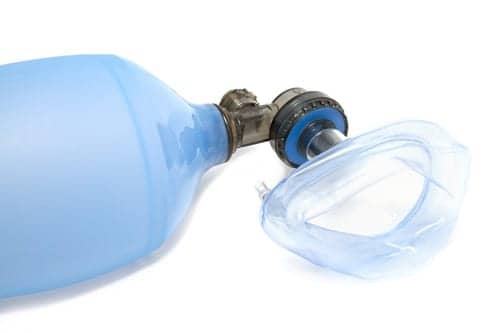Intrathoracic pressure regulation (IPR) is a therapy that enhances negative pressure in the chest and has been shown to effectively improve circulation of blood to the brain and other vital organs.
Research shows that in cases of cardiac arrest, every minute between collapse and return of spontaneous circulation decreases survival odds by 10%.1 According to the American Heart Association, in 2016 there were over 350,000 out-of-hospital cardiac arrests.2 Of these cases, the overall survival rate was a meager 12%.3 Researchers point out that poor perfusion leads to poor survival and affects neurological function in those who survive.4 Thus, using CPR techniques that target perfusion—specifically, improving it—can lead to improved survival and cognitive function. One such CPR technique is intrathoracic pressure regulation (IPR), which regulates negative intrathoracic pressure by “leveraging the body’s own physiology.” 4
Physiology of CPR
According to Eric V. Ernest, MD, EMT-P, FACEP, FAEMS, an assistant professor in the Department of Emergency Medicine at the University of Nebraska Medical Center, the classic model of cardiac arrest compresses the heart between the sternum and spinal column to create positive pressure and blood circulation. “The positive pressure that we’re putting on the chest, that’s what’s causing the heart to empty, and there’s that negative pressure during the decompression phase, or the recoil phase, that is allowing that heart to refill with blood,” Ernest explained in a recent webcast hosted by RT Magazine.5
He emphasized this “recoil phase” and how much blood the CPR intervention brings back into the thoracic cavity, and subsequently into the heart, is vitally important. “We’re kind of pre-loading or pre-priming that pump for the next time we do a compression on the chest,” Ernest said. “And, so, every time there’s a chest wall recoil, we have that negative pressure that draws the blood back in.”
Ernest explained that looking at pressure and flow models of how much blood actually gets to our vital organs via traditional CPR, it’s only about 25% to 40% in optimal conditions of normal blood flow to the heart and brain. “We’re not doing a phenomenal job at perfusing those vital organs. he said. “We’re getting some blood to it, it’s helping with the gas exchange and metabolic processes, but, really, it’s not where we want to be.”
Specifically related to the recoil phase, not much more than -2 to -4 cmH2O is being generated, he said. “So, the question becomes, what if there’s a way to enhance our negative intrathoracic pressure?” said Ernest. “This is really the area where we want to focus on, maximizing the amount of blood coming back to the chest and increasing our preload.”
Intrathoracic Pressure Regulation (IPR) Therapy
Intrathoracic pressure regulation therapy is designed to maximize the amount of negative pressure caregivers can generate within the patient’s chest. “IPR therapy increases preload, so we’re going to bring more blood back into the heart to give it an increased volume to pump out the next time we’re either compressing on the chest or the heart decides to beat on its own,” Ernest explained. “Thus, we’re increasing cardiac output, so getting more perfusion and the ability to perfuse the vital organs.”
Improving circulation of blood to the brain and other vital organs, such as the liver, is very important, and not only improves survival but neurological outcomes as well. What’s more, IPR therapy decreases intercranial pressure.
“The big veins that drain the head and the neck, most of those do not have valves, especially the larger ones. We’re relying on the idea that, if we’re creating negative pressure in the chest, it’s gonna draw that blood back from the brain and the neck, and that’s gonna create forward flow of blood to the brain,” said Ernest. “So, in effect, we are decreasing intercranial pressure by enhancing negative pressure inside the chest. The more we can do this, the better perfusion we are going to get to the brain, and thus, hopefully, have less brain-dead folks after their cardiac arrests.”
In order to understand the effects of IPR therapy, researchers sometimes contrast it with continuous positive airway pressure (CPAP). “IPR works in the opposite manner as CPAP, which instead generates positive intrathoracic pressure by forcing air into the lungs,” according to research published in JEMS.4 CPAP, which can be used to treat pulmonary edema, creates positive pressure to purge the lungs of fluids and has an opposing effect on circulation as IPR.4 “CPAP decreases cardiac output and blood pressure, while IPR therapy increases them,” the JEMS article explained.4
Delivering IPR Therapy
The reason that traditional CPR only generates 25% to 40% of normal blood flow to organs is due to the air that fills the lungs during chest wall recoil. In the absence of that air, negative pressure or a “vacuum” would naturally occur. Thus, a device is needed to preserve that vacuum. “If there’s nothing on the patient, we get the status quo of air and blood rushing back with really minimal-to-no negative pressure from the chest,” Ernest said. “So, this is where the impedence threshold device (ITD) comes in.”
The ITD is typically inserted in the airway stack between the mask and bag, but can be used really with any kind of airway device, according to Ernest, including bag-valve masks, intubated patients, those with supraglottic airways, and more. Although it sits in the airway stack, an ITD should be thought of as a circulatory device, according to Ernest. “It serves as a one-way valve; we’re going to try to stop air from rushing back into the patient during that recoil phase of cardiac arrest. And what that will hopefully do is, as opposed to bringing air back into the chest, that negative pressure is going to draw more blood back into the chest,” he explained.
Data4 has shown that the addition of the ITD during active compression decompression CPR (ACD-CPR) lowered intrathoracic pressures from -1 mmHg to -5 to -7 mmHg, and decreased peak negative intrathoracic pressure to -12 cmH2O.
“As we progress through [CPR], we’re able to generate more and more negative pressure with the ITD. We’re getting more and more of an enhanced vacuum, more and more blood back to the heart, and thus increasing our preload,” Ernest said. “It’s a noninvasive therapy that will increase overall circulation, help with cardiac output.”
Don’t Forget the HQ-CPR
The data on IPR via ITD is positive, but Ernest emphasized the importance and necessity of high quality CPR. Starting chest compressions as soon as possible, compressing at the correct rate and depth, using feedback systems, allowing complete chest recoil, not hyperventilating, switching CPR providers to prevent fatigue, and minimizing interruptions, are all the foundation of resuscitation and clear the way for enhanced therapies like IPR.
“High quality CPR is really what’s important. If we can add in some additional tools like the ITD, we’re going to increase our chance of survivability that much more,” Ernest said. RT
For more information contact [email protected].
References
- Report: U.S. out-of-hospital cardiac arrest survival rates “unacceptably low.” EMS1.com. https://www.ems1.com/ems-products/cpr-resuscitation/articles/2255015-Report-U-S-out-of-hospital-cardiac-arrest-survival-rates-unacceptably-low. July 2, 2015.
- CPR Facts and Stats. American Heart Association Inc. Heart.org. https://cpr.heart.org/AHAECC/CPRAndECC/AboutCPRECC/CPRFactsAndStats/UCM_475748_CPR-Facts-and-Stats.jsp
- CPR Facts and Stats. American Heart Association Inc. Heart.org. https://cpr.heart.org/AHAECC/CPRAndECC/AboutCPRECC/CPRFactsAndStats/UCM_475748_CPR-Facts-and-Stats.jsp
- Convertino, V. Using Intrathoracic Pressure Regulation to Enhance Blood Flow in Hypotensive and Cardiac Arrest Patients. JEMS.com. https://www.jems.com/articles/supplements/special-topics/perfusion-demand/using-intrathoracic-pressure-regulation.html. Published November 23, 2014.
- Getting Positive Blood Flow Out of Negative Pressure: IPR Therapy and the ITD.”
respiratory-therapy.com. https://respiratory-therapy.com/2019/01/webinar-getting-positive-blood-flow-negative-pressure-ipr-therapy-itd. Published January 16, 2019.










